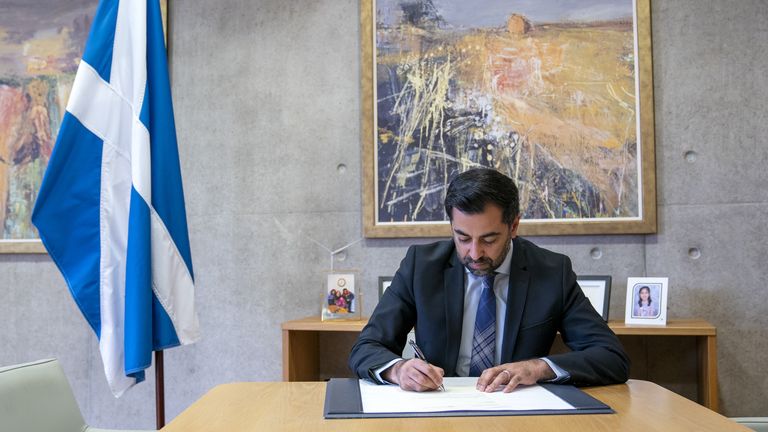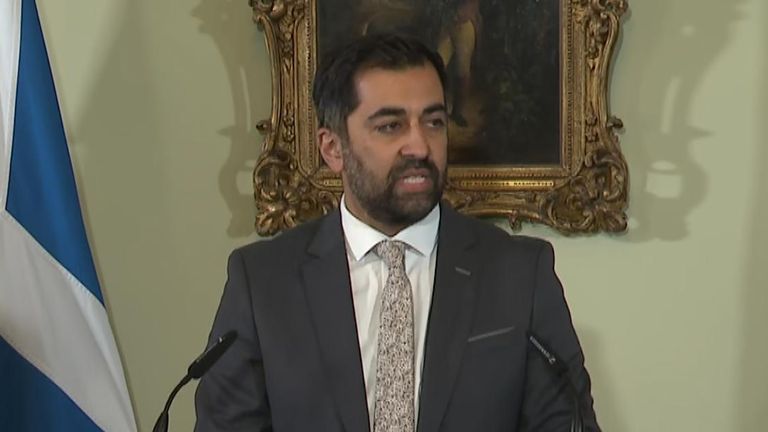Is Humza Yousaf entitled to £52,000 a year for life after his resignation?


When Humza Yousaf resigned as Scotland’s first minister, questions were raised over what his pension would be.
Some on social media have claimed the 39-year-old is entitled to £52,000 per year for the rest of his life – and payments will begin immediately.
There’s just one problem: this isn’t true.
Please use Chrome browser for a more accessible video player
0:24
Yousaf signs resignation letter
While such a pension scheme used to be in place, it was scrapped in 2009.
So what will he receive… and when?
When he reaches the Scottish Parliamentary Pension Scheme retirement age – which is currently 65 – Mr Yousaf will be entitled to up to around £2,600 per year for the period he served as first minister.
The former SNP leader is also entitled to further retirement payments from his time as an MSP and as a Holyrood minister.
A law introduced in 1999 said that “any person who has held the office of first minister or presiding officer shall, on ceasing to hold that office”, be entitled to a pension.
It added that “the annual amount of a pension payable under this article shall be equal to one half of the salary”.
Advertisement
But 10 years later, new legislation was passed that meant that anyone who became first minister after 2009 was no longer entitled to that type of pension.
Please use Chrome browser for a more accessible video player

2:06
‘I’m sad my time is ending’
The first minister of Scotland is currently paid £176,780 per year – but £72,196 of that amount is for their work as an MSP and would not be included in such a calculation.
If the old rules were still in place today, Mr Yousaf would have been entitled to a pension of £52,292, which is half of £104,584 – his additional pay for being leader.
But Mr Yousaf was elected first minister on 19 March 2023, so is not covered by the previous law. Instead, that part of his pension entitlement will be based only on his time in office up to his resignation on 7 May.
MSPs have two pension options which mean they can contribute either a higher or a lower proportion of their salaries each year.
If an MSP contributes the higher rate, they are entitled to one-fortieth of their final annual salary as a pension. If they contribute the lower rate, they are entitled to one-fiftieth of their final salary as a pension.
👉 Listen above then tap here to follow the Sky News Daily wherever you get your podcasts 👈
Because Mr Yousaf served for just over a year as first minister, he will be entitled to a pension of either one-fortieth or one-fiftieth of £104,584. That would equate to around £2,600 or £2,100 per year, depending on which option he chose.
He will also be entitled to a pension for the years he serves as an MSP. Mr Yousaf was elected as a regional Glasgow MSP in 2011 and in 2016 became the Glasgow Pollok MSP, an office he still holds.
If he were to step down today after 13 years in Holyrood – assuming he had been paying the higher contribution for that entire period – he would be entitled to a little under £23,500 per year, which is added to his first minister pension.
Read more from Sky News:
SNP finance probe heading to prosecutors ‘within weeks’
The 25th anniversary of the Scottish parliament

Keep up with all the latest news from the UK and around the world by following Sky News
Mr Yousaf is also entitled to further pension payments from his various ministerial roles.
He served as a minister for five years and nine months in the Scottish parliament and then as a Scottish secretary of state for four years and nine months. Combined, these entitle Mr Yousaf to another pension pot of a little over £7,200.
By the calculations on current figures, and assuming he has contributed the higher rate for all of his time as an MSP, Mr Yousaf is currently entitled to around £33,300 in yearly pension payments when he retires at, or beyond, age 65.

